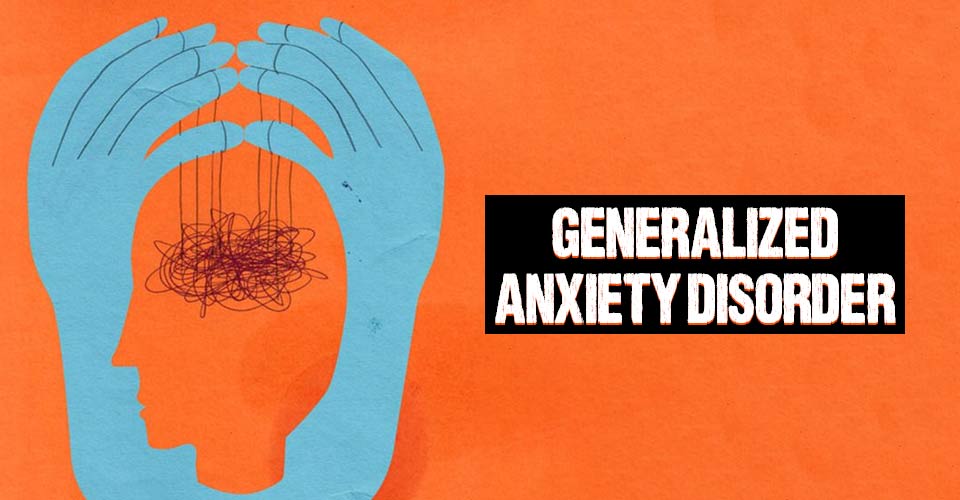Do you tend to worry all day or feel excessively anxious and tense? Although some amount of anxiety can be healthy, Generalized Anxiety Disorder (GAD) can severely affect your daily life and wellbeing.
What Is Generalized Anxiety Disorder?
Generalized Anxiety Disorder is an anxiety disorder 1 National Institute of Mental Health. (2019). Anxiety disorders. Nih.gov; National Institute of Mental Health. Available from: https://www.nimh.nih.gov/health/topics/anxiety-disorders involving an uncontrollable and lingering sense of worry or dread. It is often characterized by –
- Muscle tension
- Restlessness
- Insomnia
- Irritability
- Fatigue
As they tend to anticipate disaster, people with generalized anxiety disorder often visualize a bleak future and expect the worst possible outcomes without any apparent reason. Even if they realize that their fears are exaggerated 2 Generalized anxiety disorder: Overview. (2017, October 19). Nih.gov; Institute for Quality and Efficiency in Health Care (IQWiG). Available from: https://www.ncbi.nlm.nih.gov/books/NBK279595/ , they can’t seem to control them.
GAD can significantly affect a person’s ability to function in their daily life and interfere with their relationships, career, and personal health. See the image below for common signs and symptoms of GAD.
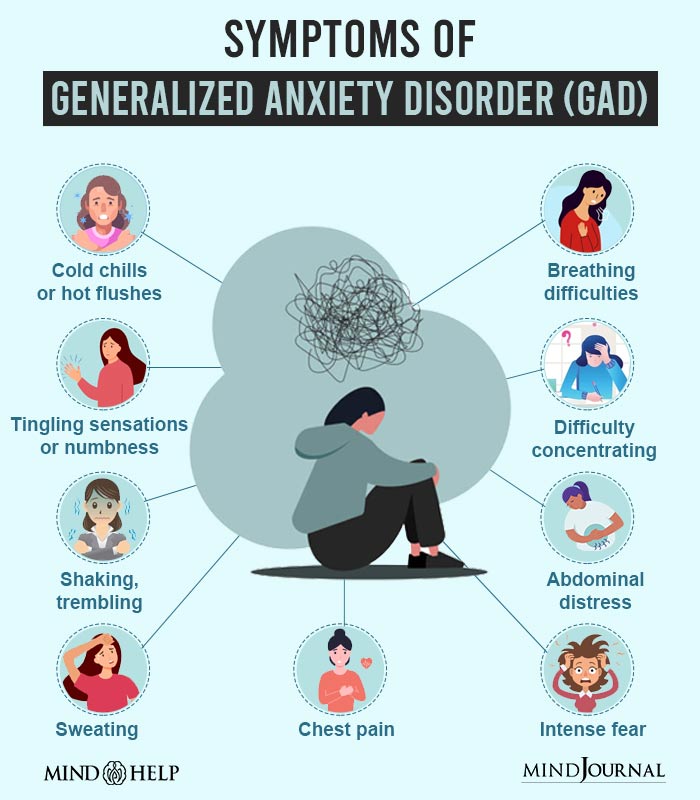
Read More About The Symptoms Of GAD Here
Case Example
Rega, a 35 year old woman often described herself as a “chronic worrier”.
Ever since she could remember, she had been stressed about something or the other, be it her education, her career, her family or random day to day events.
Whenever Rega had to go on a vacation or take up a big project at work, or host people at her place, she would invariably start feeling sick. This was because she always imagined the worst possible thing that could happen in every situation.
Her all-consuming fear that something might go wrong almost always left her feeling extremely tired, irritated, and unable to do any work.
Rega had been this way for as long as she could remember. However, when her lack of productivity due to extreme stress led her to being fired from her job, she finally decided to seek help and was eventually diagnosed with generalised anxiety disorder.
Anxiety Vs Generalized Anxiety Disorder
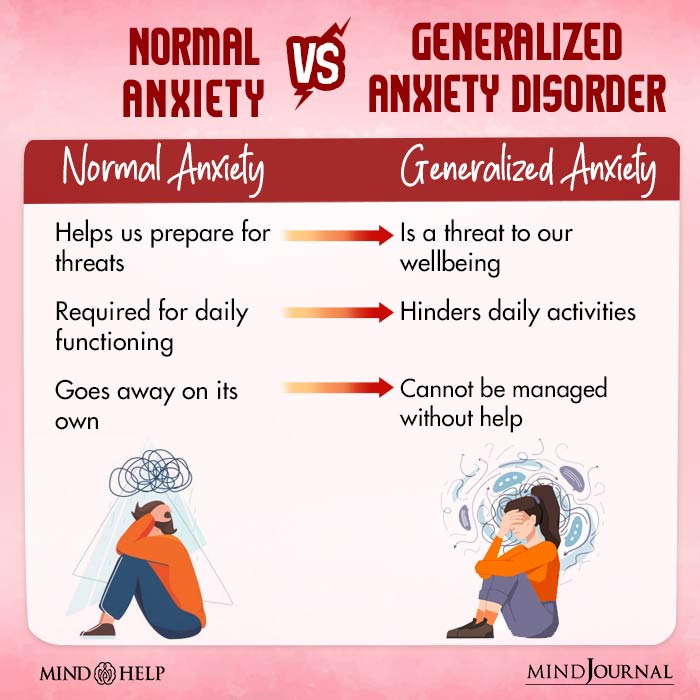
While normal anxiety helps us prepare for imminent threats, a disproportionate amount of anxiety can itself become a threat to our well-being.
People with generalized anxiety disorder are in a perpetual state of worry over day-to-day issues that are relatively non-threatening. Thus, instead of being an aid to one’s functioning, anxiety in the form of GAD continuously acts as a hindrance to one’s daily activities.
Occasional feelings of anxiety tend to go away on their own as soon as the perceived threat is handled. However, generalized anxiety disorder is more persistent and usually cannot be managed without treatment.
How Is GAD Different From Other Mental Health Issues?
As anxiety is a common symptom of a number of mental health conditions, GAD can often be confused with other disorders 3 Mohlman, J., de Jesus, M., Gorenstein, E. E., Kleber, M., Gorman, J. M., & Papp, L. A. (2004). Distinguishing generalized anxiety disorder, panic disorder, and mixed anxiety states in older treatment-seeking adults. Journal of anxiety disorders, 18(3), 275–290. https://doi.org/10.1016/S0887-6185(02)00261-X , like
- Panic disorder (Read more)
- Social anxiety disorder (Read more)
- Obsessive-compulsive disorder (Read more)
- Specific phobias (Read more), etc.
However, what distinguishes GAD from other anxiety disorders is that people with this condition usually do not need a trigger to start worrying. Unlike panic disorder and phobias, there is no sudden onset of fear symptoms in generalized anxiety disorder. GAD is a chronic condition that people often learn to live with.
Generalized Anxiety Disorder In Children
GAD in children, also known as a pediatric generalized anxiety disorder 4 Keeton, C. P., Kolos, A. C., & Walkup, J. T. (2009). Pediatric generalized anxiety disorder: epidemiology, diagnosis, and management. Paediatric drugs, 11(3), 171–183. https://doi.org/10.2165/00148581-200911030-00003 , occurs in over 10% of children. It can co-exist with other conditions such as separation anxiety disorder and social anxiety disorder. The symptoms of generalized anxiety disorder in children are usually reported by parents, caregivers, or teachers.
Generalized anxiety disorder in adults manifests in a slightly different way than it does in children. The latter often experience more somatic symptoms such as gastrointestinal issues, headaches, and heart palpitations.
The exact cause of GAD is still unknown, but researchers have found different factors that may contribute to the development of this condition such as genetic predisposition, poor quality of interpersonal relationships, traumatic environment, unhealthy lifestyle habits, etc.
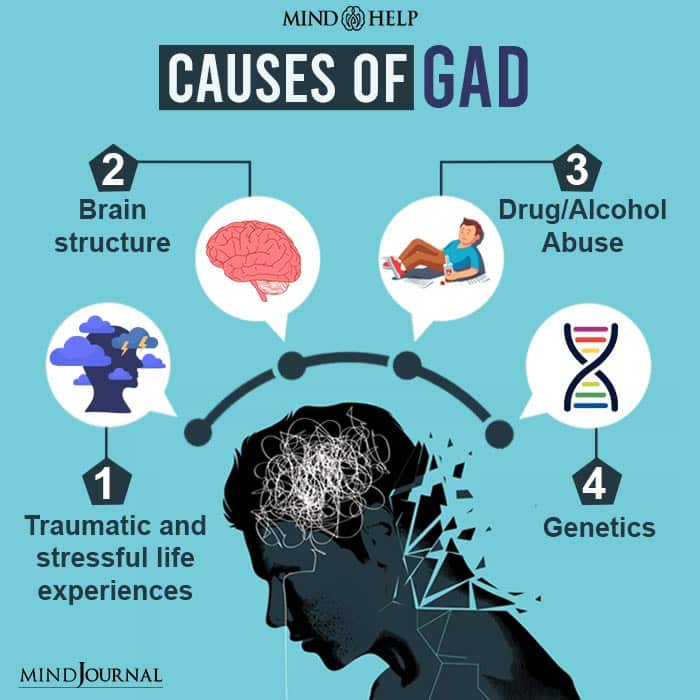
Read About Causes Of Generalized Anxiety Disorder Here
Prevalence Of GAD
Nearly 20% of people 5 Torpy, J. M., Burke, A. E., & Golub, R. M. (2011). JAMA patient page. Generalized anxiety disorder. JAMA, 305(5), 522. https://doi.org/10.1001/jama.305.5.522 across the globe experience anxiety disorders.
According to the Anxiety and Depression Association of America (ADAA 6 Anxiety & Depression Association of America. (2019). Generalized Anxiety Disorder (GAD) | Anxiety and Depression Association of America, ADAA. Adaa.org. Available from: https://adaa.org/understanding-anxiety/generalized-anxiety-disorder-gad ), around 3.1% of the American population or 6.8 million U.S. adults are affected by generalized anxiety disorder each year. Women 7 National Institute of Mental Health. (n.d.). NIMH» Generalized Anxiety Disorder. Www.nimh.nih.gov. Available from: https://www.nimh.nih.gov/health/statistics/generalized-anxiety-disorder are more likely to have this condition than men. Moreover, around 5.7% of adults in the U.S. experience GAD at least once in their lifetime.
A report from Harvard Health 8 Publishing, H. H. (2014, December 5). Generalized anxiety disorder. Harvard Health. Available from: https://www.health.harvard.edu/anxiety/generalized-anxiety-disorder states that the prevalence of generalized anxiety disorder increases with age.
Moreover, GAD can often develop along with other mental disorders. Around 66% of patients with GAD also suffer from major depression, while 25% experience panic disorder.
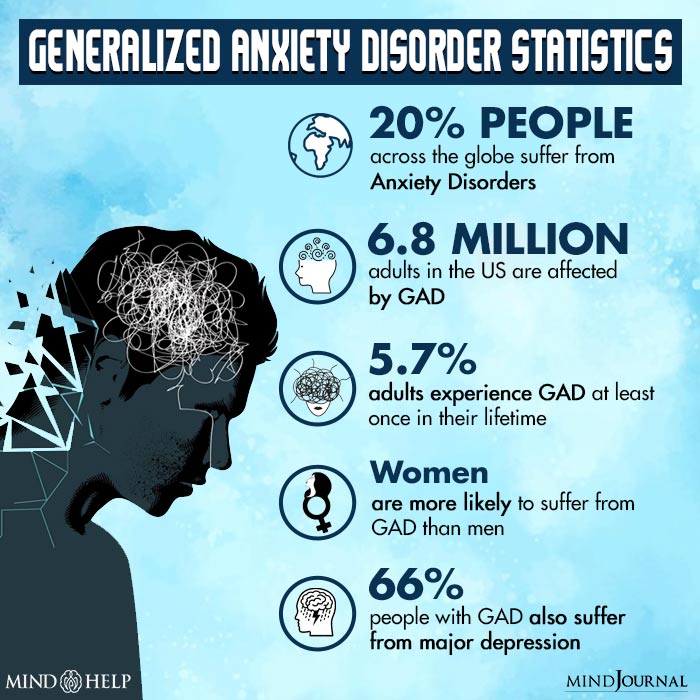
Diagnosing GAD
According to the Diagnostic and Statistical Manual of Mental Disorders (DSM-5 9 American Psychiatric Association. (2013). DSM-5. Psychiatry.org; American Psychiatric Association. Available from: https://www.psychiatry.org/psychiatrists/practice/dsm ), a diagnosis of generalized anxiety disorder can be made if symptoms have persisted for 6 months or more, and have resulted in significant impairment in daily functioning.
A mental health professional usually takes a detailed interview and may conduct certain psychometric assessments to come to a diagnosis. The GAD-7 10 Sapra, A., Bhandari, P., Sharma, S., Chanpura, T., & Lopp, L. (2020). Using Generalized Anxiety Disorder-2 (GAD-2) and GAD-7 in a Primary Care Setting. Cureus, 12(5), e8224. https://doi.org/10.7759/cureus.8224 is a common tool used to assess the symptoms of generalized anxiety disorder.
Some medical tests 11 Munir, S., & Takov, V. (2022). Generalized Anxiety Disorder. In StatPearls. StatPearls Publishing. Available from: https://www.ncbi.nlm.nih.gov/books/NBK441870/ such as blood glucose test, thyroid test, screening for substance abuse etc. may also be recommended to rule out other causes for the GAD symptoms.
Living With Generalized Anxiety Disorder
Only a person suffering from the disorder knows what it feels like to live with GAD. People with this disorder often start worrying without any provocation which can make it difficult for them to complete their tasks and get through the day. Severe worry can even lead to certain physical symptoms like
- Headaches
- Nausea
- Sweating
- Lightheadedness
- Trembling
- Shortness of breath
People with GAD are also prone to depression and substance use. Moreover, GAD has been proven to be linked with cardiac diseases 12 Celano, C. M., Daunis, D. J., Lokko, H. N., Campbell, K. A., & Huffman, J. C. (2016). Anxiety Disorders and Cardiovascular Disease. Current psychiatry reports, 18(11), 101. https://doi.org/10.1007/s11920-016-0739-5 and other medical illnesses.
GAD can be physically, mentally, and emotionally exhausting, and overcoming it is a challenging process. However, with the right treatment and self-care (see the image below), the symptoms can be managed effectively.
- Read About Treatment Of Generalized Anxiety Disorder Here
- Read About Ways To Cope With Generalized Anxiety Disorder Here
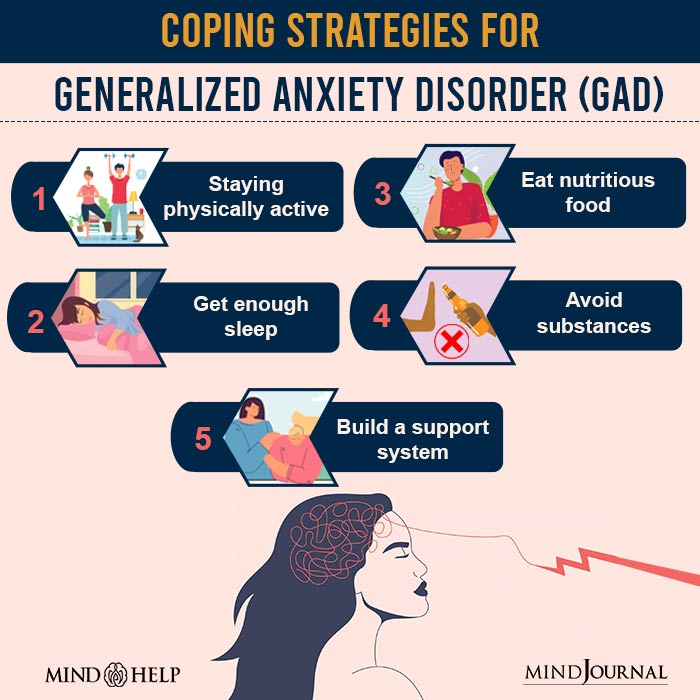
Takeaway
Generalized anxiety disorder can be a debilitating condition. However, professional treatment, along with a healthy lifestyle can greatly help a person deal with it. Support from family and friends can also go a long way. With time, a person with GAD may be able to live a normal and healthy life.
At A Glance
- Generalized Anxiety Disorder (GAD) is an anxiety disorder that involves irrational and uncontrollable worry throughout the day.
- Around 6.8 million U.S. adults are affected by generalized anxiety disorder each year.
- It is often characterized by extreme worrying, insomnia, muscle tension, restlessness, irritability, fatigue, etc.
- People can develop this condition either as a child or as an adult.
- Psychotherapy and medication, along with a healthy lifestyle can greatly help a patient combat GAD.
Frequently Asked Questions (FAQs)
1. Is generalized anxiety disorder genetic?
Generalized anxiety disorder has a moderate genetic risk 13 Gottschalk, M. G., & Domschke, K. (2017). Genetics of generalized anxiety disorder and related traits. Dialogues in clinical neuroscience, 19(2), 159–168. https://doi.org/10.31887/DCNS.2017.19.2/kdomschke of about 30%. It can be triggered by a variety of biopsychosocial causes.
2. What is the difference between generalized anxiety disorder and phobic disorder?
In phobias, the fear is focused on a specific object, place, or event whereas in generalized anxiety, it is more broad and widely based.
3. What is the difference between GAD and OCD?
While anxiety disorders share several features in common, the basic difference between GAD and OCD 14 National Institute of Mental Health. (2019, October). Obsessive-Compulsive Disorder. National Institute of Mental Health (NIMH). https://www.nimh.nih.gov/health/topics/obsessive-compulsive-disorder-ocd) is the fact that the latter involves repetitive compulsive behavior, which is absent in the former.
4. Can you have GAD without panic attacks?
Panic attacks are not a symptom of GAD. However, they may sometimes co-occur.
5. Can GAD be cured?
Although anxiety cannot completely go away, GAD can be treated with various medications and psychotherapy.
References:
- 1National Institute of Mental Health. (2019). Anxiety disorders. Nih.gov; National Institute of Mental Health. Available from: https://www.nimh.nih.gov/health/topics/anxiety-disorders
- 2Generalized anxiety disorder: Overview. (2017, October 19). Nih.gov; Institute for Quality and Efficiency in Health Care (IQWiG). Available from: https://www.ncbi.nlm.nih.gov/books/NBK279595/
- 3Mohlman, J., de Jesus, M., Gorenstein, E. E., Kleber, M., Gorman, J. M., & Papp, L. A. (2004). Distinguishing generalized anxiety disorder, panic disorder, and mixed anxiety states in older treatment-seeking adults. Journal of anxiety disorders, 18(3), 275–290. https://doi.org/10.1016/S0887-6185(02)00261-X
- 4Keeton, C. P., Kolos, A. C., & Walkup, J. T. (2009). Pediatric generalized anxiety disorder: epidemiology, diagnosis, and management. Paediatric drugs, 11(3), 171–183. https://doi.org/10.2165/00148581-200911030-00003
- 5Torpy, J. M., Burke, A. E., & Golub, R. M. (2011). JAMA patient page. Generalized anxiety disorder. JAMA, 305(5), 522. https://doi.org/10.1001/jama.305.5.522
- 6Anxiety & Depression Association of America. (2019). Generalized Anxiety Disorder (GAD) | Anxiety and Depression Association of America, ADAA. Adaa.org. Available from: https://adaa.org/understanding-anxiety/generalized-anxiety-disorder-gad
- 7National Institute of Mental Health. (n.d.). NIMH» Generalized Anxiety Disorder. Www.nimh.nih.gov. Available from: https://www.nimh.nih.gov/health/statistics/generalized-anxiety-disorder
- 8Publishing, H. H. (2014, December 5). Generalized anxiety disorder. Harvard Health. Available from: https://www.health.harvard.edu/anxiety/generalized-anxiety-disorder
- 9American Psychiatric Association. (2013). DSM-5. Psychiatry.org; American Psychiatric Association. Available from: https://www.psychiatry.org/psychiatrists/practice/dsm
- 10Sapra, A., Bhandari, P., Sharma, S., Chanpura, T., & Lopp, L. (2020). Using Generalized Anxiety Disorder-2 (GAD-2) and GAD-7 in a Primary Care Setting. Cureus, 12(5), e8224. https://doi.org/10.7759/cureus.8224
- 11Munir, S., & Takov, V. (2022). Generalized Anxiety Disorder. In StatPearls. StatPearls Publishing. Available from: https://www.ncbi.nlm.nih.gov/books/NBK441870/
- 12Celano, C. M., Daunis, D. J., Lokko, H. N., Campbell, K. A., & Huffman, J. C. (2016). Anxiety Disorders and Cardiovascular Disease. Current psychiatry reports, 18(11), 101. https://doi.org/10.1007/s11920-016-0739-5
- 13Gottschalk, M. G., & Domschke, K. (2017). Genetics of generalized anxiety disorder and related traits. Dialogues in clinical neuroscience, 19(2), 159–168. https://doi.org/10.31887/DCNS.2017.19.2/kdomschke
- 14National Institute of Mental Health. (2019, October). Obsessive-Compulsive Disorder. National Institute of Mental Health (NIMH). https://www.nimh.nih.gov/health/topics/obsessive-compulsive-disorder-ocd)

